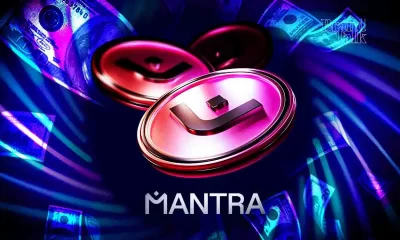Takes
The lack of soft forks is due to a lack of interest— not a lack of process
Published
4 months agoon
By
admin


As I explained in a Take two weeks ago, I think the threat (or promise, depending on your perspective) of protocol ossification is somewhat exaggerated, at least at this point in time.
Yes, the rate of soft forks has slowed down significantly over the years, the last one having been Taproot in 2021. But it seems this has more to do with a lack of interest in the potential upgrades that’ve been proposed since then, rather than it being due to the lack of a good process for deploying protocol upgrades. (Although that is not exactly a solved problem either.)
Bitcoin Core developers are generally funded on a no-strings-attached basis or outright volunteers, meaning they’re not required to work on any specific part of the codebase. As such, their time and energy will be dedicated to whatever they find most interesting or important to work on. So far, that hasn’t really been any of the soft fork proposals: the various covenant-style opcodes aren’t unequivocally perceived to offer the type of groundbreaking use cases that deserve prioritization, and while Drivechains sound great in theory, their major downside is still that miners can ultimately steal coins from them.
But even if Bitcoin Core developers aren’t interested, that doesn’t mean it’s impossible to upgrade Bitcoin. For better or worse, anyone with the right skillset (admittedly not a very low bar) can always deploy a soft fork through an alternative client, even as a user activated soft fork (UASF). Yet, despite some rumblings from time to time, no one has done this yet.
I suspect this is at least in part because the proponents of these soft forks aren’t convinced a UASF would actually be successful. And if a UASF wouldn’t be successful, maybe the upgrade is not worth doing in the first place…
This article is a Take. Opinions expressed are entirely the author’s and do not necessarily reflect those of BTC Inc or Bitcoin Magazine.
Source link
You may like


Crypto markets ‘relatively orderly’ despite Trump tariff chaos: NYDIG


Fartcoin ‘Hot Air Rises’ — $1.50 Just A Whiff Away


What happened to the RWA token?


Crypto Strategist Sees Solana-Based Memecoin Surging Higher, Says One AI Altcoin Flashing Strong Chart


Mantra Team Responds As The OM Token Price Crashes Over 80% In 24 Hours


This Week in Crypto Games: Gaming Tokens Crash Out, Eve Frontier Opens Up
bitcoin mixing
More Deputy Attorney General, Less New York Attorney General
Published
2 days agoon
April 11, 2025By
admin

On Monday, Deputy Attorney General (DAG) Blanche published a memo entitled “Ending Regulation By Prosecution” in which he stated that the U.S. Department of Justice will stop its crackdown on bitcoin and crypto mixers.
Here’s the exact language he used in the memo:
“…the Justice Department will stop participating in regulation by prosecution in this space. Specifically, the Department will no longer target virtual currency exchanges, mixing and tumbling services, and offline wallets for the acts of their end users or unwitting violations of regulations…”
The following day, New York Attorney General (NYAG) James co-authored a letter in which she called on congressional leaders to create federal crypto regulation, in part to prevent the use of crypto mixers for illicit purposes.
Here’s what she and her co-authors had to say about crypto mixers:
“Effective legislation must require cryptocurrency platforms to expressly comply with anti-money laundering laws, know your customer (“KYC”) regulations and cyber security protocols to prevent the use of cryptocurrency to finance terrorism, adversarial regimes, and crime. Cryptocurrency that cannot be fully traced, such as those going through money laundering mixers, must not be allowed to be converted, directly or indirectly, to U.S. dollars.”
While DAG Blanche gave the benefit of the doubt to users of Bitcoin and crypto mixers, NY AG James implied that all users of such mixers are criminals, as she refers to the technology as “money laundering mixers.”
Such language is deeply concerning to hear from the attorney general of a state — much less any lawyer — as it presumes guilt.
NY AG James has employed this type of rhetoric around Bitcoin and crypto since she assumed the attorney general role in 2018, and it’s unfair because 1.) she’s never once acknowledged that human rights and pro-democracy activists use mixers to preserve both their privacy and the privacy of their donors and 2.) U.S. citizens have a right to financial privacy.
So, as the topic Bitcoin privacy becomes more prominent in the political sphere, be sure to do your part to amplify the type rhetoric that DAG Blanche is using while pushing back on the dangerous and unjust rhetoric from the likes of NY AG James.
It’s up to us to make our voices heard on this issue and to let our elected officials know that it matters to us, especially as the Samourai Wallet and Tornado Cash cases unfold (more on both cases in the discussion below).
The fight for our right to transfer value across the internet privately is afoot. Please don’t stay on the sidelines.
This article is a Take. Opinions expressed are entirely the author’s and do not necessarily reflect those of BTC Inc or Bitcoin Magazine.
Source link
Bitcoin mining
The U.S. Tariff War With China Is Good For Bitcoin Mining
Published
4 days agoon
April 10, 2025By
admin
Today, China announced that it will increase tariffs on the goods it ships to the United States from 34% to 84% in response to President Trump stating that he will raise tariffs on the goods the U.S. ships to China to 104%.
The increased Chinese tariffs on the U.S. will make it more costly for U.S.-based public Bitcoin mining companies to purchase ASICs (the premier machines used to mine bitcoin), the majority of which are produced in China.
And this will be largely beneficial for the health of the Bitcoin mining ecosystem.
As Troy Cross eloquently explained in “The Future OF Bitcoin Mining Is Distributed”, if one country controls too much of the Bitcoin hashrate, Bitcoin’s censorship resistance — one of its core value propositions — is put at risk.
In the article, Cross highlighted that if the majority of the Bitcoin network’s hashrate is not only produced in the U.S. but produced by American public mining companies, the U.S. government has more leverage to mandate that these companies only mine OFAC-compliant blocks.
For those who believe that these companies would push back or simply not follow such orders, please note that Marathon Digital Holdings, the largest publicly-traded Bitcoin mining company in the U.S., has already proven that it’s willing to comply with OFAC regulations.
The Bitcoin network has a higher likelihood of maintaining its censorship resistance when the hashrate is distributed globally.
As Cross mentioned in a recent interview (below), Bitcoin differs from other emerging technologies in that it does not benefit from one country controlling most of the industry around it.
He acknowledges that this isn’t necessarily intuitive, and that the notion may be confusing to the likes of those who are behind President Trump when he declares that he wants “all bitcoin made in the U.S.A.”
With the Bitcoin network, it’s best for countries to control a sizable portion of the network but not more than 50% of it.
And as Cross mentioned in the interview above, he believes that the U.S. may already control more than 50% of the hashrate.
However, this trend may now begin to reverse in the wake of China’s tariff increase on the U.S., because it will now be cheaper for the competitors of public U.S.-based Bitcoin miners to obtain ASICs than it will be for these companies.
So, while the escalating tariff war may be incredibly anxiety-inducing on a number of levels, consider taking some solace in the fact that it may be good for Bitcoin.
Source link
Bitcoiners
We’ve Turned A Generation Of Bitcoiners Into Digital Goldbugs
Published
3 weeks agoon
March 26, 2025By
admin

Bitcoin is a technology. It is not some force of the universe, some natural element or mineral that was “discovered” floating out in the ether. It is a technology. Technologies are created by human beings, not discovered. They are designed. That design has intent, elements of it are made specifically in a way to facilitate that intent. The tolerances of what a technology can or cannot handle are a result of those design decisions, which are in turn a result of the intent.
New Bitcoiners are being brought into the world of Bitcoin through a lens that obscures and distorts the realities of Bitcoin as a technology and what that entails, and tries to pack it into the box of “digital gold.”
Bitcoiners are becoming goldbugs. People who thing Bitcoin is some magic thing that is decentralized “just cause,” whose future success is preordained and an absolute certainty.
This is a disastrous way for people to conceptualize Bitcoin. Bitcoin is a decentralized computer network. The conditions of a network are not a static thing. Environments change, network loads change, behavior of network users change. All of these things can have impacts on the viability and functioning of the network itself.
Gold doesn’t need patches for vulnerabilities. Gold doesn’t have to overhaul major subsystems because a change in user behavior overloaded them to the point of not functioning correctly or efficiently. Gold doesn’t need to worry about Denial of Service attack vectors that could disrupt, or worst case bring down, the entire “gold network.”
Bitcoin does. Bitcoin is not “digital gold,” it is a decentralized network made of software individuals actually have to run and maintain. The Bitcoin goldbugs have completely lost connection with this reality, at least when it comes to rationally assessing risks to Bitcoin, or ways it genuinely could fail or be co-opted.
Bitcoin is going to have problems it needs to solve, at a fundamental technical level. It already does, and it will have more. This is how technology works, it is an inherent part of it. Bitcoin’s value stems from its use as a censorship resistant network, a freedom money no one can stop you from using. That is its core valuable characteristic.
That characteristic hinges entirely on its decentralized nature.
If people do not work to defend that decentralized nature, to interact with Bitcoin in a decentralized fashion, to improve and fix it as needed to counteract limitations or pressures encouraging centralization, then it will not remain decentralized.
We are going to very soon regret the consequences of focusing so much outreach the last few cycles purely on spreading this “digital gold” narrative. This entire generation of Bitcoiners does not fundamentally understand that decentralization isn’t a static unchanging characteristic set in stone forever.
It needs to be maintained.
This article is a Take. Opinions expressed are entirely the author’s and do not necessarily reflect those of BTC Inc or Bitcoin Magazine.
Source link
Michael Saylor Teases New Bitcoin Buy After Strategy’s $7.69 Billion Q1 BTC Buying Spree

Crypto markets ‘relatively orderly’ despite Trump tariff chaos: NYDIG

Fartcoin ‘Hot Air Rises’ — $1.50 Just A Whiff Away

What happened to the RWA token?

Crypto Strategist Sees Solana-Based Memecoin Surging Higher, Says One AI Altcoin Flashing Strong Chart

Mantra Team Responds As The OM Token Price Crashes Over 80% In 24 Hours

This Week in Crypto Games: Gaming Tokens Crash Out, Eve Frontier Opens Up

Commerce Secretary Lutnick walks back tariff relief on electronics

Gold ETF Inflows Hit Three-Year High as PAXG, XAUT Outperform Wider Crypto Market

Israel’s New Study Shows 51% Of Public Is Interested In Adopting CBDC (Digital Shekel) – Is That So?

Solana Price Eyes Breakout Toward $143 As Inverse Head & Shoulders Pattern Takes Shape On 4-hour Chart

Crypto malware silently steals ETH, XRP, SOL from wallets

Binance Executives Met With US Government Officials To Discuss Easing of Regulatory Supervision: Report

Michael Saylor Hints At Another MicroStrategy Bitcoin Purchase, BTC Price To Rally?

From the Crypto Trenches to the Hill: Why Solana Is Making a Big Push in Washington

Arthur Hayes, Murad’s Prediction For Meme Coins, AI & DeFi Coins For 2025

Expert Sees Bitcoin Dipping To $50K While Bullish Signs Persist

Aptos Leverages Chainlink To Enhance Scalability and Data Access

Bitcoin Could Rally to $80,000 on the Eve of US Elections

Crypto’s Big Trump Gamble Is Risky

Sonic Now ‘Golden Standard’ of Layer-2s After Scaling Transactions to 16,000+ per Second, Says Andre Cronje

Institutional Investors Go All In on Crypto as 57% Plan to Boost Allocations as Bull Run Heats Up, Sygnum Survey Reveals

Ripple-SEC Case Ends, But These 3 Rivals Could Jump 500x

Has The Bitcoin Price Already Peaked?

A16z-backed Espresso announces mainnet launch of core product

The Future of Bitcoin: Scaling, Institutional Adoption, and Strategic Reserves with Rich Rines

3 Voting Polls Show Why Ripple’s XRP Price Could Hit $10 Soon

Xmas Altcoin Rally Insights by BNM Agent I

Blockchain groups challenge new broker reporting rule

I’m Grateful for Trump’s Embrace of Bitcoin
Trending

 24/7 Cryptocurrency News5 months ago
24/7 Cryptocurrency News5 months agoArthur Hayes, Murad’s Prediction For Meme Coins, AI & DeFi Coins For 2025

 Bitcoin3 months ago
Bitcoin3 months agoExpert Sees Bitcoin Dipping To $50K While Bullish Signs Persist

 24/7 Cryptocurrency News3 months ago
24/7 Cryptocurrency News3 months agoAptos Leverages Chainlink To Enhance Scalability and Data Access

 Bitcoin5 months ago
Bitcoin5 months agoBitcoin Could Rally to $80,000 on the Eve of US Elections

 Opinion5 months ago
Opinion5 months agoCrypto’s Big Trump Gamble Is Risky

 Altcoins2 months ago
Altcoins2 months agoSonic Now ‘Golden Standard’ of Layer-2s After Scaling Transactions to 16,000+ per Second, Says Andre Cronje

 Bitcoin5 months ago
Bitcoin5 months agoInstitutional Investors Go All In on Crypto as 57% Plan to Boost Allocations as Bull Run Heats Up, Sygnum Survey Reveals

 Price analysis5 months ago
Price analysis5 months agoRipple-SEC Case Ends, But These 3 Rivals Could Jump 500x


